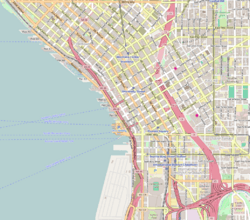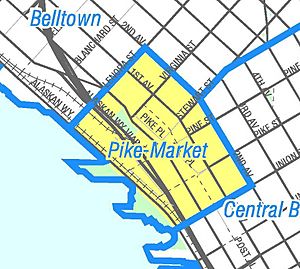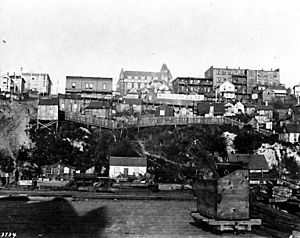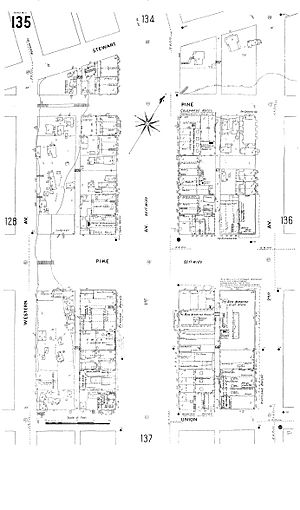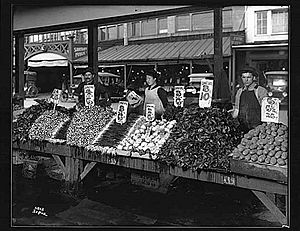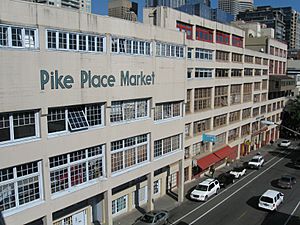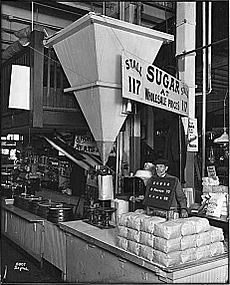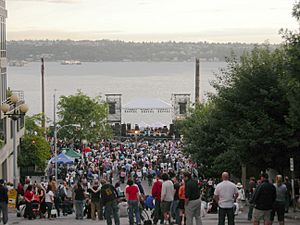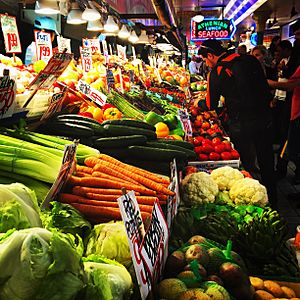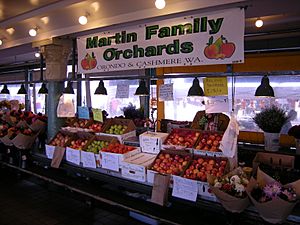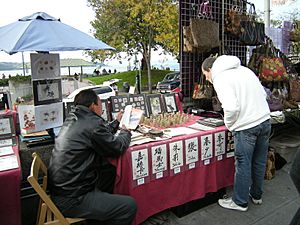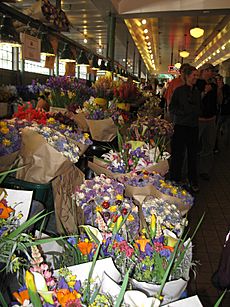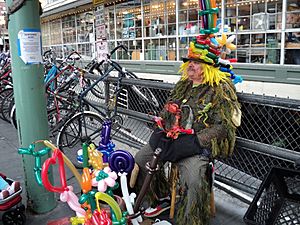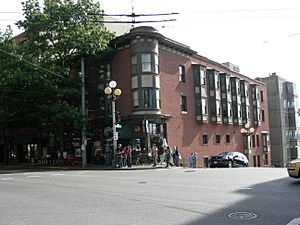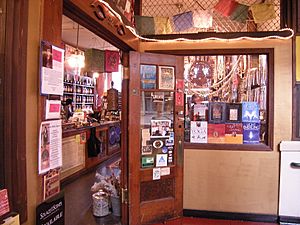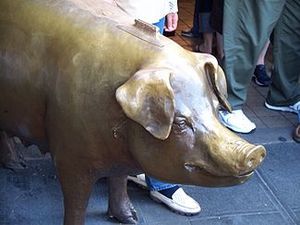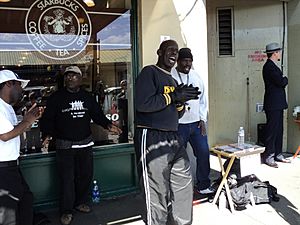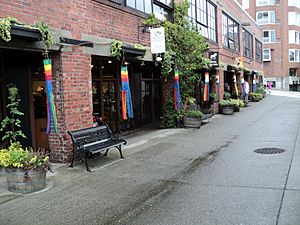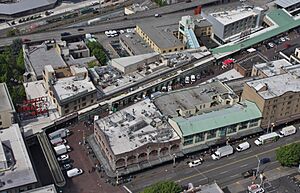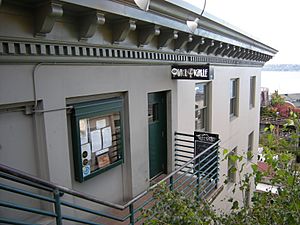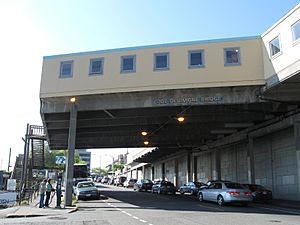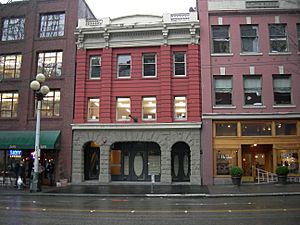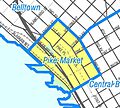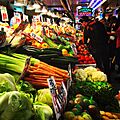Pike Place Market facts for kids
Quick facts for kids |
|
|
Pike Place Public Market Historic District
|
|
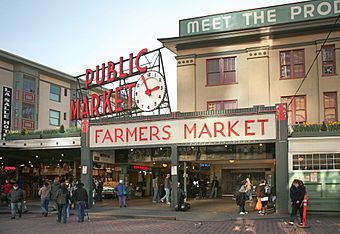 |
|
| Location | Seattle, Washington, U.S. |
|---|---|
| Built | 1903, 1910, 1971 |
| Architect | Frank Goodwin |
| NRHP reference No. | 70000644 |
| Added to NRHP | March 13, 1970 |
Pike Place Market is a famous public market in Seattle, Washington, United States. It first opened on August 17, 1907. It is one of the oldest farmers' markets in the U.S. that has always been open. The Market is right by the water, looking out over Elliott Bay and Puget Sound. It's a busy place where many small farmers, craftspeople, and merchants sell their goods. The Market is named after Pike Place, the street it's on, which runs from Pike Street to Virginia Street in Downtown Seattle. Pike Place Market is Seattle's most popular place to visit. It's also one of the most visited tourist spots in the world, with over 10 million people coming each year!
The Market is built on a steep hill and has several levels below the main street. Each level has different shops, like antique dealers, comic book stores, and small family restaurants. On the main street level, you'll find fishmongers, fresh produce stands, and craft stalls under covered walkways. Local farmers and artists sell their items all year long from tables they rent daily. This follows the Market's main goal: to let shoppers "Meet the Producer" directly.
Pike Place Market is home to almost 500 people who live in eight different buildings. Many of these homes used to be for people with lower incomes. A special group called the Pike Place Market Preservation and Development Authority (PDA) manages the Market.
Contents
Where to Find Pike Place Market
The Market is in the northwest part of Seattle's main business area, Downtown Seattle. To the north is Belltown. To the southwest are the waterfront and Elliott Bay. The streets here are angled, following the shoreline of Elliott Bay.
Different groups have slightly different ideas about where the Market's exact borders are. The City Clerk's map shows a larger "Pike-Market" neighborhood. It stretches from Union Street to Virginia Street and from the waterfront to Second Avenue.
The "Pike Place Public Market Historic District" is a smaller area listed on the U.S. National Register of Historic Places. This special district is mainly between First Avenue, Virginia Street, Western Avenue, and a wall near Union and Pike Streets.
The Seattle Department of Neighborhoods has its own official "Pike Place Market Historical District." This area is about 7-acre (28,000 m2) and includes the federal historic district plus a bit more land closer to Elliott Bay. These different definitions sometimes came from disagreements between people who wanted to save the Market and those who wanted to build new things.
Part of the Market is on land that used to be mudflats below the hills west of Pike Place. In the late 1800s, West Street (now Western Avenue) was already a road running along the shore. Railroad Avenue (now Alaskan Way) was built even further out on wooden supports. It wasn't filled in with land until the 1930s. Nearby docks with warehouses were ready by 1905, two years before the Market opened.
History of Pike Place Market
Before the Market Opened
Before Pike Place Market started in 1907, local farmers sold their goods in an area called The Lots. This was located at Sixth Avenue and King Street. Most of their produce then went to large wholesale businesses on Western Avenue, known as Produce Row. Farmers often had to sell their goods through these wholesalers. They would get a percentage of the final sale price. Sometimes, farmers made a profit, but often they just broke even or got no money at all. There were also rumors of unfair practices by the wholesalers.
How the Market Started
People were unhappy with how farmers were treated. So, Thomas P. Revelle, a Seattle city councilman and newspaper editor, found an old city rule. This rule allowed the city to create public markets. He suggested using part of Pike Place as a temporary public market. This street was a new wooden road near Pike Street and First Avenue. On August 5, 1907, the city council agreed.
On Saturday, August 17, 1907, the Market officially opened. City Council President Charles Hiram Burnett Jr. declared it "Public Market Day." About ten farmers brought their wagons to a boardwalk next to the Leland Hotel. There were rumors that wholesalers tried to stop farmers from coming. But hundreds of customers arrived, and all the farmers' produce sold out before noon!
Early Growth of the Market
In 1907, Frank Goodwin and his brothers owned the Leland Hotel and land around Pike Place. They saw how popular the Market was and started selling nearby plots of land. Soon, they began building what is now the Main Arcade of Pike Place Market.
The first Market building, the Main Arcade, opened on November 30, 1907. By 1911, the Market had grown a lot. The number of stalls had doubled, reaching from Pike Street to Stewart Street. The west side of the stalls was covered, becoming known as the "dry row." In 1916, the Goodwins bought a long-term lease on the Bartell Building. This building, renamed the Economy Market, became an expansion of the Main Arcade.
In the early 1920s, the north side of the Corner Market became the Sanitary Market. It had delis, butchers, restaurants, and bakeries. Small boats, called the "mosquito fleet," brought shoppers from islands in Puget Sound. Market sellers also brought goods directly to the docks. The area became a lively social spot.
In 1920, the Seattle City Council tried to ban farmers' stalls from the street. This was due to complaints about traffic. But farmers, merchants, and citizens protested. The Goodwins then proposed expanding the Market even more. In April 1921, the city council decided to keep the Market in its current location. The Goodwins immediately started new expansions.
World War II and Japanese Americans
When Pearl Harbor was bombed in December 1941, many farmers at Pike Place Market were Japanese-Americans. Some historians believe they made up most of the farmers selling produce. On February 19, 1942, President Franklin D. Roosevelt signed Executive Order 9066. This order forced all Americans of Japanese heritage in certain areas, including the West Coast, into internment camps. This meant many Japanese Americans lost their homes and businesses.
Saving and Expanding the Market Again
In 1963, there was a plan to tear down Pike Place Market. The idea was to replace it with "Pike Plaza," which would have a hotel, apartments, offices, a hockey arena, and a parking garage. The mayor and many city council members supported this. However, many people in the community were against it. Groups like "Friends of the Market" fought to save it.
On November 2, 1971, people voted to create a historic preservation zone. This vote saved the Market and put it back under public control. The Pike Place Market Preservation and Development Authority (PDA) was created to manage it. During the 1970s, all the Market's old buildings were fixed up. They used the original plans and materials to make them look like new again.
Modern Day Market Life
In the 1980s, money for social services in the Market became harder to get. So, the Pike Place Market Foundation was started. This group raises money for the Market's free clinic, senior center, low-income housing, and childcare center. Also in the 1980s, the wooden floors in the main covered area were replaced with tiles. People could pay $35 to have their name carved on a tile. Between 1985 and 1987, over 45,000 tiles were put in, raising nearly $1.6 million.
The Hildt Agreement in 1983 helped balance how stalls were given out to farmers and craftspeople. This agreement set rules that lasted for many years. It gave craftspeople priority in the North Arcade and farmers priority everywhere else.
Victor Steinbrueck Park, just north of the Market, was once called Market Park. It used to have an armory building, which was damaged by fire in 1962. The city took over the land in 1968, and the armory was torn down. In 1970, it became a park. The park was redesigned in 1982. After Victor Steinbrueck died in 1985, it was renamed after him. He was very important in saving the Market.
Market's 100th Birthday
Pike Place Market celebrated its 100th birthday on August 17, 2007. Many activities and events took place. There was a concert in Victor Steinbrueck Park with songs about Seattle. Famous musicians like Stone Gossard and Mike McCready from Pearl Jam performed.
How the Market Works
Organizations That Help the Market
The Pike Place Market is managed by the Pike Place Market Preservation & Development Authority (PDA). This group was created in 1973 under Washington State law. It has a 12-member volunteer council. The PDA's job is to protect and fix up the Market's buildings. They also help farmers and food sellers. They support small businesses and provide services for people with low incomes. The PDA gets its money from rent and other fees paid by businesses in the Market.
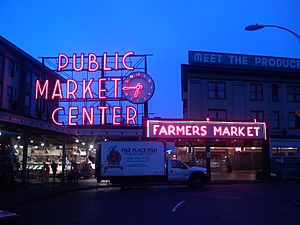
The same law that created the PDA also created the Pike Place Market Constituency in 1973. This group elects one member to the PDA Council each year. Anyone 16 or older living in Washington State can join for $1 a year.
The Market Historical Commission also helps run the Market. It was started in 1971 to keep the Market's special look and feel. This commission must approve any big changes to the buildings or signs in the historic district. Its 12 members are appointed by the mayor.
Another important group is the Pike Place Merchants Association. It started in 1973 but has roots back to the Farm Association in the 1920s. This group helps Market sellers with things like legal advice and insurance. It also publishes the monthly Pike Place Market News.
There are other groups too, like the Daystall Tenants Association (DTA) for stall vendors. The United Farmers Coalition (UFC) represents farmers who sell produce and flowers. The Pike Market Performers' Guild, started in 2001, represents street performers.
Friends of the Market was a key group that helped save the Market in the 1960s and 70s. They still have two seats on the Historical Commission and give tours. The Market Foundation, started in 1982, supports services for low-income people. It also helps with heritage programs and building repairs.
Market Rules and Policies
The Market's "Meet the Producer" rule means that both craftspeople and farmers can rent daystalls. Farmers get first choice for stalls, but the Market also values handmade arts and crafts. Stalls are usually between 4 feet (1.2 m) and 5.5 feet (1.7 m) wide. Craftspeople have priority in some areas, and farmers in others. If one group doesn't fill their spots, the other can rent them.
To keep their spot, farmers must be at the Market one day a week. Craftspeople must be there two days a week. This ensures that the people selling are the ones who made or grew the items. Farmers can also pass their permits down to family members.
The Market allows many farm products, like produce, flowers, eggs, and meat. There are also rules for selling other items like wild berries or holiday wreaths. These can be sold with farm products but cannot be the main items.
Farmers, craftspeople, and performers all pay a yearly permit fee. In 2008, this was $35 for farmers and craftspeople, and $30 for performers. Farmers and craftspeople also pay daily rent for their stalls. This rent changes depending on the season and day of the week. Performers do not pay daily fees.
Performers have a special role in the Market. They can entertain shoppers and accept donations. They can also sell their music or recordings. However, they cannot actively ask for donations or sell other products. Performers do not have assigned spots or times. They use an honor system for waiting in line for a spot. Loud instruments like brass or drums are not allowed. Some spots are only for "quiet" performances.
Most businesses in the Market are run by their owners. The PDA helps new businesses and those that serve low-income people. They also help businesses that are important to the Market's unique character, like fish, produce, and meat sellers.
Housing and Help for People
The Market also provides homes for people with lower incomes and offers social services. The Market Foundation supports the Pike Market Medical Clinic, Pike Market Senior Center, Downtown Food Bank, and Pike Market Childcare and Preschool. These are all located within the Market. They also help with low-income housing nearby.
The Foundation gives "Market Fresh" coupons to low-income residents. These can be used to buy produce at the Market. They also have a FoodLink program that gives unsold Market produce to other Seattle food banks. Money put into the Market's giant piggy bank goes to this foundation.
About 500 people live in the Market. Around 90% are older adults with lower incomes who get help with their rent. Their average income is about $11,095 a year. Some of these homes are in the LaSalle Hotel and Market House.
The Pike Market Medical Clinic helps about 3,600 patients. Many of these are older, have disabilities, or face mental health challenges.
Around 900 people use the Market's senior center. They can get hot lunches, help finding housing and jobs, and take classes. These classes include fitness, health, language, and computer training.
The Downtown Food Bank is in the Public Market Parking Garage. It provides groceries to about 1,000 people each week. They also deliver groceries to homebound residents. About 160 families get baby milk, food, and diapers.
The childcare and preschool helps 90–100 families with young children each year. Most of these families have lower incomes and get help with tuition. The school also provides breakfast, lunch, and snacks. It has a staff member to help families find resources they need.
Fun Things to See and Do
One of the Market's biggest attractions is Pike Place Fish Market. Here, employees throw large salmon and other fish to each other instead of passing them by hand. When a customer orders a fish, an employee throws it over the counter. Another employee catches it and gets it ready for sale.
The very first Starbucks coffee store, started in 1971, was originally at 2000 Western Avenue. In 1977, it moved one block away to 1912 Pike Place. It has been there ever since. The store was opened by three friends: Jerry Baldwin, Zev Siegl, and Gordon Bowker. They wanted to sell high-quality coffee beans. The sign outside this store is special. It shows the original logo, a bare-breasted siren, which came from an old Norse woodcut. It also has a pig statue named "Pork'n Beans."
Tenzing Momo is an herbal shop that has been in the Market for over 30 years. It opened in 1977. Its name means "divine dumpling" in Tibetan. Nearby, Market Spice (founded 1911) sells other spices and herbs.
The Market Heritage Center at 1531 Western Avenue is a small museum. It teaches visitors about the Market's history.
Pike Place Market is Seattle's most popular tourist spot. It is also one of the most visited attractions in the world, with over 10 million visitors each year.
Rachel and Pigs on Parade
The unofficial mascot of Pike Place Market is Rachel. She is a bronze piggy bank that weighs 550 pounds (250 kg). Rachel has been at the corner of Pike Place since 1986. She was designed by local artist Georgia Gerber. Rachel collects about US$6,000–$9,000 each year in money from all over the world. This money goes to the Market Foundation to help fund the Market's social services.
Rachel inspired the "Pigs on Parade" fundraiser. This event first happened in 2001. It was like other events in cities where decorated animal statues were displayed. Another "Pigs On Parade" fundraiser was held in 2007 for the Market's 100th birthday. This also happened to be the Chinese zodiac Year of the Pig.
Street Performers (Buskers)
Since the 1960s, Pike Place Market has been known for its street entertainers. These performers are often called buskers. Famous buskers include spoons player Artis the Spoonman and songwriter Jim Page. Other performers have played instruments like the steel guitar and ukulele. There are also a cappella gospel singers and jazz musicians.
Jump blues musician PK Dwyer is known for starting the first street band to play at the Market. He formed Felix & the Freelicks in 1971. This band and others he formed played at the Market for many years.
Places to Eat and Drink
Pike Place Market has many places to eat and drink. You can find everything from quick snacks to fancy restaurants. The Athenian Inn, in the Main Market, has been a restaurant since 1909. Three Girls Bakery started in 1912 and was one of Seattle's first businesses started by women. It still sells many baked goods and sandwiches.
The Pink Door is a popular Italian restaurant hidden on upper Post Alley. It has a unique dining room, live jazz, and an outdoor deck with views of Elliott Bay. Il Bistro, located below the street, is another Italian restaurant known for its romantic feel. It helped start the trend of fine dining in Seattle in 1977.
Other old Market restaurants include Lowell's, a casual spot in the Main Market. Maximilien is a French restaurant that has been praised by famous chef Julia Child. The Copacabana is Seattle's only Bolivian restaurant. It's upstairs in the Triangle Building and has a balcony overlooking Pike Place.
Important People of the Market
Frank Goodwin and his brothers built most of the Market's main buildings. He decided to keep the buildings simple. This was to make sure the focus was on the products, not fancy decorations. When he retired in 1925, his nephew Arthur Goodwin took over.
Giuseppe Desimone came to America from Italy. He became a successful farmer. He was a longtime Market seller and eventually became its owner in 1925. He was president of the Market until he died in 1946. He is also known for helping Boeing stay in Seattle in 1936.
His son, Richard Desimone, became president after him and served until 1974. He kept the Market going during tough times for farmers' markets. He often did business with handshakes instead of formal agreements.
Victor Steinbrueck was an architect and activist who helped define the Pike Market area. Artist Mark Tobey also showed the neighborhood in his art. In the 1960s, there were plans to tear down the Market for new buildings and parking. But people in the city and preservation activists fought to save it. In 1971, citizens voted to protect the Market.
For many years, Sol "The Cod Father" Amon of Pure Food Fish was the longest-serving seller at Pike Place Market. His father started selling fish there in 1911. Sol took over the Pure Food Fish Company in 1956. He often chats with visitors and helps them choose fish. The Seattle City Council honored him in 2006. They named him "King of the Market" and made April 11 "Sol Amon Day." Sol Amon is a big supporter of the Market Foundation.
Walter DeMarsh of Mobeta Shoes has made custom shoes since 1979. He helps people with foot problems.
Market Buildings
Most of the old buildings in the Pike-Market area are not individually listed as landmarks. Instead, they are part of larger historic districts. This gives them protection without needing separate listings.
Main Market Buildings
The Market started on a boardwalk next to the Leland Hotel (built 1900). In 1907, engineer John Goodwin added the Leland into the Main Arcade. Later, he and architect Andrew Willatsen expanded this area into the Fairley Building. This complex is now called the Main Market. The upper two floors of the Leland are still housing today.
The two-story Triangle Building (built 1908) originally housed a poultry company. It was later joined with the nearby 3-story Silver Oakum Building (built 1910). The Outlook Hotel (now LaSalle Hotel, built 1908) also dates from this time. It used to be a hotel for workingmen. Since 1977, it has been connected to the Cliff House (around 1901) and mostly provides low-income housing. Shops and the Market PDA office are on the ground floor.
The Sanitary Market (built 1910) was supposedly named because horses were not allowed inside. A fire in 1941 badly damaged the building. It was rebuilt with rooftop parking. Later, the parking lot was replaced with two floors of homes.
The North Arcade (built 1911 and 1922) was a big expansion of the Main Market. It added 160 covered stalls.
The 3-story Corner Market building (built 1912) is on the right as you enter the Market from Pike Street. The Three Girls Bakery, one of the first businesses in the Corner Market, is now in the nearby Sanitary Market. The basement used to have a jazz club and is now home to anarchist bookstore Left Bank Books.
Across Pike Street from the Corner Market is the Economy Market (built 1900, remodeled 1916). In 1978, it was renovated and connected to the new South Arcade (built 1985). The South Arcade is outside the protected historic Market areas. It has condominium apartments and businesses like the Pike Pub & Brewery.
The Joe Desimone Bridge crosses Western Avenue. It used to connect the North Arcade to the Municipal Market Building, which was torn down after a fire in 1974. The bridge is now enclosed and used for craft stalls.
Other old buildings in the Market include the Champion Building (built 1928), which was once a garage. The Soames-Dunn Building (built 1918) once sold seeds and paper bags. It now houses the "original" Starbucks. The Stewart House Hotel (built 1902–1911) was a hotel for workingmen and now has shops and low-income housing. The Seattle Garden Center (built 1908) is now home to Sur La Table. The Fix-Madore Building (built 1916) is an office and retail building connected to the Main Market by a footbridge.
Newer buildings in the Market include the Post Alley Market (built 1983) and the Inn at the Market (built 1985). The Pike and Virginia Building (built 1978) and the Market Heritage Center (built 1999) are also newer. All these buildings have designs that fit with the historic Market architecture. The Pike Street Hill Climb (built 1976) connects the Market to the waterfront.
Historic Buildings Near the Market
Some buildings near the Market are also historic. The Alaska Trade Building (built 1915) and the Butterworth Building (built 1903) are both listed on the National Register of Historic Places (NRHP). Other NRHP-listed buildings nearby include the J. S. Graham Store (built 1919) and the U.S. Immigration Building (built 1915).
Other city landmarks near the Market include the Terminal Sales Building (built 1923–1925) and Pier 59, which is now home to the Seattle Aquarium.
Getting Around the Market
The main part of the Market is on Pike Place, a two-block street about 940 feet (290 m) long. It runs between Pike Street and Virginia Street. Cars can drive one-way on this street, even though many people walk there. Sometimes the street is closed to cars for events. But there are often discussions about making it a permanent pedestrian zone. This is a "perennial issue" because the Market is a working market, and businesses need space for loading and unloading goods.
The Market is close to the Westlake Center transit hub. You can get there by Link light rail at Westlake station, the Seattle Center Monorail, and the South Lake Union Streetcar. There are plans to extend the streetcar to stop on 1st Avenue next to the Market, but this project is currently on hold.
See also
 In Spanish: Mercado de Pike Place para niños
In Spanish: Mercado de Pike Place para niños
Images for kids


